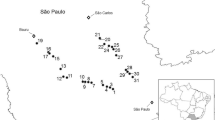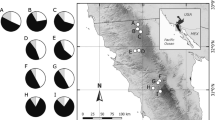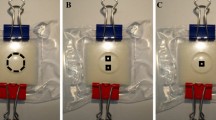Abstract
Larvae of the wild multivoltine bruchid seed beetle Bruchidius dorsalis infest dry mature seeds of the Japanese honey locust Gleditsia japonica. The frequency distribution of B. dorsalis larvae per seed was examined in the laboratory. First, preliminary observation showed that the first-instar B. dorsalis larva crawled from an eggshell and traveled in excess of 25 cm before boring into a seed. Larvae prefer boring into noninfested rather than infested seeds (indicated by a previous emergence hole). When a larva occasionally bored into a previously infested seed, it could emerge as an adult in spite of decreased body weight. Second, we conducted experiment 1 to investigate the frequency distributions of the number of boring holes per seed; results showed significantly regular distributions (a smaller variance than Poisson) in which most seeds had been bored by one larva. Third, we performed experiment 2 to examine the relationship between the initial number of larvae boring into one seed and the number of emerged adults and their body weight from a given seed. When we increased the ratio of egg density to seed abundance by experimental manipulation, multiple larvae (up to ten) could bore into one seed. However, only one adult emerged from each of about 85% seeds with multiple borings. When one adult emerged, the adult body weight was constant, independent of the initial number of larvae boring into the seed. Two adults occasionally emerged from one seed with a large difference in their body sizes. Even in this case, the larger adult was as heavy as that in a single emergence, although the other was significantly smaller (about 60%) than the normal size. These results show severe contest-type competition among B. dorsalis larvae within one seed. The winner often monopolizes almost all the resources even though a part of the seed resource still remains.
Similar content being viewed by others
Author information
Authors and Affiliations
Additional information
Received: September 17, 2001 / Accepted: October 5, 2001
Rights and permissions
About this article
Cite this article
Shimada, M., Kurota, H. & Toquenaga, Y. Regular distribution of larvae and resource monopolization in the seed beetle Bruchidius dorsalis infesting seeds of the Japanese honey locust Gleditsia japonica . Popul Ecol 43, 245–252 (2001). https://doi.org/10.1007/s10144-001-8188-2
Issue Date:
DOI: https://doi.org/10.1007/s10144-001-8188-2




